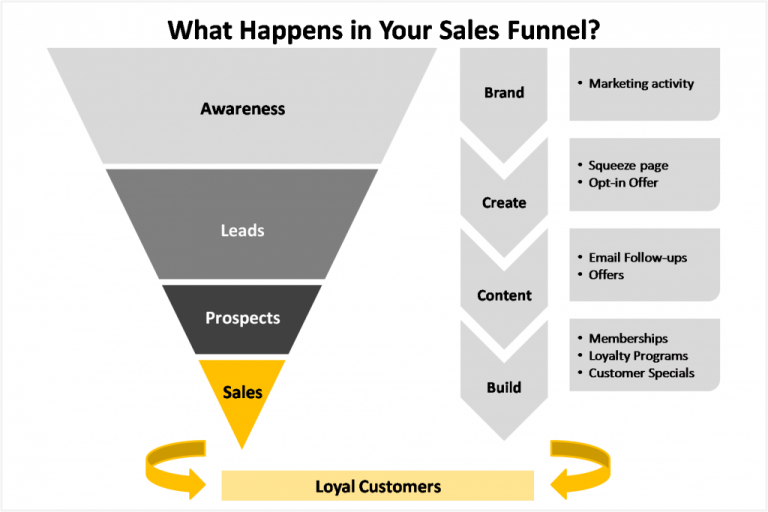
14 May Sales Funnel Management: How to Keep Leads Flowing
Your sales lead funnel is the process of how you qualify and filter a wide range of leads into paying customers. It allows you to focus your attention on the people who are most likely to buy. It also adds structure and a degree of predictability to a variable sales process.
Every company has its preferred approach to sales and marketing. But there are some universal tips to sales funnel management that anyone can use. This article breaks down what your sales funnel should generally look like and what things to consider in the development of your sales funnel management.

Sales Funnel Overview
A sales funnel generally contains three segments: the Top, Middle and Bottom.
Top of the Funnel (TOFU)
At the top is where you have the point of entry for potential leads. This often initiated by the hand-off between the marketing and sales departments. Once a marketing qualified lead makes it through the marketing funnel, it enters the sales funnel and becomes a sales qualified lead. How a person arrives here is usually the result of an effective marketing strategy (SEO, social media, email marketing, etc.). A good marketing funnel will thoroughly vet lead prospects so that those who enter the sales funnel are in the best position to convert into a paying customer.
This section of the sales funnel stages is the widest as it is here that the largest volume of sales leads are. Leads at this stage only know about your company or organization through marketing materials. An initiation for leads to explore your site and services and ask questions are highly recommended at this stage. Don’t try to sell anything, but rather build rapport and portray a positive company experience and image.
Middle of the Funnel (MOFU)
By the end of the Middle of the Funnel stage, a prospect is in a position to become a customer. During this sales funnel stage, a prospect will be shopping around for the best solution to their concern, question, issue or need. He or she will be looking at your business and comparing it with your competitors. During this stage, it is important to follow-up with the lead. This can be done via phone calls and email. However, it is important to not follow-up too earnestly or frequently as this can annoy and scare the prospect away. The Middle of the Funnel is also a good opportunity to offer discounts and offers.
A visitor converts to a lead at the middle section of the funnel. This occurs when someone fills out a form in exchange for relevant, valued content. However, just because a lead arrives in the middle of the funnel doesn’t necessarily mean he or she is a qualified lead. The lead may show interest, but may be unwilling to follow through with a purchase or partnership commitment. It is important to measure engagement, urgency, and interests of the prospects at this point and develop targeted messaging and advertising to these prospects.
Bottom of the Funnel (BOFU)
The bottom of the funnel is the point of conversion from lead to a sales opportunity. At this sales funnel stage, the prospect has chosen to do business with you and is ready to make a purchasing decision. To get an idea of where the sales qualified lead is at in regards to how ready he or she is in pulling the trigger, below are some indicators to look at and consider:
- Frequency of visits to your site
- How many conversations with a sales rep
- LinkedIn profile views
It’s important that once a lead converts and makes a purchase, the job of the salesperson isn’t done. He or she must continue communication and relationship building with the customer so that he or she becomes a loyal, repeat customer.
Qualifying Your Leads
When someone shows enough interest, that person becomes a Marketing Qualified Lead (MQL). This MQL is then handed off to the sales team in which it then becomes a sales qualified lead (SQL). Depending on the lead, you can place this lead in the middle of the funnel. These leads are ready for your full pursuit.
Building Your Sales Funnel
A good sales funnel allows you to understand your own sales team and its performance. Use it to see your customers’ behavior and motivations. If you don’t have a sales funnel, here a few guidelines to help you build one:
Know Your Buyer
Understanding your customer is the foundation of your sales funnel. Conduct surveys and reference market studies to learn interests and behavior. This knowledge helps you to differentiate yourself and communicate more effectively and empathetically with your buyers.
Focus on Quality, Not Quantity
Effective sales efforts aren’t about talking to as many people as possible. They’re about focusing energy on the leads with the most potential to convert into sales. Your sales funnel should move low-quality contacts out of the flow as soon as possible to enable higher quality ones to more freely move forward through the sales pipeline stages.
A Happy Sales Team = A Healthy Business
Revenue is the lifeblood of any business. And who brings in the revenue? The sales department. It’s critical to train your sales reps in a way that optimizes the sales motion, while at the same time fostering a culture of innovation, learning and customer satisfaction.
Another crucial aspect of your sales team is hiring and training the right people. Hire motivated individuals with diverse experience and abilities.
Prospecting: Where Sales Funnels Begin
You don’t need to wait for inbound marketing leads to getting your funnel moving. Generate activity. You can do this through prospecting tactics like referrals, conferences, and cold calling.
Managing Your Sales Funnel
Identifying and filtering interested leads is a challenge. A successful sales funnel tags potential sales qualified leads that will convert to paying customers. If your funnel is too complicated, it may actually hurt your business. Read on for ideas on how to keep your sales funnel running buttery smooth.
Give Adequate Training
Your sales organization should always be learning. Regular training applies to all levels, not just the newbies. Stay in the know with the latest techniques. Allow your team to share knowledge and experiences.
Focus on Qualified Leads
Passing unqualified leads onto the sales organization is wasteful. Most of these leads will never turn into sales. A smaller, more focused pool of leads offers the sales team a better use of time, energy and resources. It also increases the chance of making a sale.
Leverage Your CRM
Your CRM (customer relationship management system) is the sales funnel concept made tangible. It allows you to follow customers along the journey. It also simplifies the sales flow by automating tasks such as email marketing segmentation and the sending of emails. Your CRM will also help you measure each stage of the funnel using detailed statistics and analytics.
A CRM should not take attention away from the core sales process. Use it to help execute your sales strategy, measure progress, and automate workflows.
Unclog the Funnel
Sometimes the sales pipeline stages can get clogged. These clogs happen when a sales prospect encounters a roadblock that either derails them from moving forward through the sales funnel or it causes them to become stuck in the sales funnel stages they are currently in. Ideally, the sales process is fast, easy and smooth. However, this is often not the case. Though one can carefully plan for and develop ways around potential prospect roadblocks, there is no fool-proof way to prevent them. If you’re wondering what some of these roadblocks are, here are some examples:
- Bad contact info
- Poor brand experience
- Poor marketing communication
- A competitor has the more attractive offering
While in many cases, leads stuck in the sales funnel are seen as lost causes, this is not always the case. There are ways to save these sales qualified leads and get them un-stuck. In fact, these “dead” leads can turn into a valuable, loyal customer when all is said and done.
The first step in sales funnel management is to become familiar with the sales funnel and sales funnel stages or pipeline sales funnel stages. When sales funnel management is done effectively, a sales qualified lead will progress through the lead funnel. Sometimes, however, the sales funnel can get clogged and a sales qualified lead will stall. These “dead” leads, however, can be saved and be turned into profitable customers.
Use Aktify for Stalled Leads
There are some leads who never progress through the sales funnel stages, yet they could still qualify. They’ve stalled for some reason, and you don’t know why. Most companies put stalled sales qualified leads on ice because they don’t know what to do with them. Let Aktify find out why they’ve stalled. Plus, we revive the ones who are still interested. To learn more, click here.
Sorry, the comment form is closed at this time.